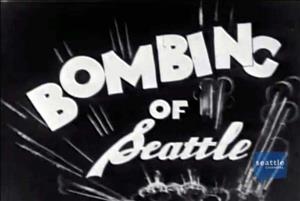On June 13, 1943, a mock bombing raid is held at Husky Stadium on the University of Washington campus in Seattle. The event is intended to demonstrate and how civilian and military defense organizations can respond in case of an enemy attack. More than 35,000 spectators are in attendance.
Be Prepared
Seattle Mayor William P. Devin (1898-1982) welcomed the crowd with a brief opening address. “This is a warning of what we can expect when we are raided by the enemy,“ the mayor stated, “We must prepare ourselves for any eventuality.” During World War II, the Puget Sound region was considered a likely target for Japanese planes.
Wearing white helmets and armbands, thousands of volunteers began the demonstration with a mass drill and marching exhibition to music played by the Fort Lawton band. This was followed by the Seattle Police Department drill team, after which 62 teams of auxiliary firemen worked in groups of three in a display of teamwork. In each group, two men steadied a ladder into the air, while the third climbed it and sprayed water from a pump can.
Before the “air attacks” began, a variety of military equipment was brought out onto the field, including anti-aircraft guns, tanks, jeeps, half-tracks, and machine guns. Once in place, a squadron of P-38 fighter planes roared overhead as the soldiers fired blanks at the aircraft.
Bombs Away
In the center of the field, a mock village had been set up for the sole purpose of being destroyed. Just as the planes went past, an incendiary bomb went off in the attic of a faux duplex apartment, and within minutes air-raid wardens had the fire extinguished. Nearby, a “forest” went up in flames, and that fire was also put out.
Exploding gas bombs came next, to demonstrate decontamination techniques. As the “victims” were enveloped by the gas cloud, announcer William A. Groce informed the audience that the course of action was to take off any contaminated clothes and to cleanse with neutralizing liquids, such as water. Newspaper and film footage of the event noted that two women stripped down to their underwear and ran around in the water spray, much to the delight of many of the men in the audience.
The squadron of P-38s returned, and bombs went off near fake telephone poles and power lines. A bogus water main erupted into the air, while a beauty and barber shop collapsed, supposedly burying more victims. Ambulances and aid cars swarmed onto the field to rescue these hapless souls.
Kaboom!
As mayhem spread across the field, narrator Groce took a quick break to announce that 8-year-old Frank Goodrich -- who was lost in the stands -- should meet his father by the popcorn wagon. The bombing raid continued apace.
The final squadron of P-38s -- 24 in all -- returned for one last run and pounded the ersatz village into pieces. Numerous TNT explosions went off, obliterating a power house, a drugstore, a corner grocery, a shoe repair store, and the “Idle Hour Tavern.” A “direct hit” was made on an oil storage dump, and flames roared up from a six-foot-long, two-foot-deep pit, darkening one end of the stadium with clouds of black smoke.
The event ended with the removal of a buried and supposedly unexploded, 500-pound bomb. It was retrieved by an Army squad from Fort Lewis, after which it was driven around the track on the back of a large truck, dangling from a chain. The crowd responded with generous applause, and officials later stated that the event was a huge success.
Mock bombing raid is held at Husky Stadium in Seattle on June 13, 1943.
- By Alan J. Stein
- Posted 8/16/2007
- HistoryLink.org Essay 8260
Sources: “35,000 See Civilian-Defense Workers Resist ‘Bomb Raid,’” The Seattle Times, June 13, 1943; “Realistic Big War Show Thrills and Warns Seattle,” Seattle Post-Intelligencer, June 13, 1943.
Licensing: This essay is licensed under a Creative Commons license that encourages reproduction with attribution. Credit should be given to both HistoryLink.org and to the author, and sources must be included with any reproduction. Click the icon for more info. Please note that this Creative Commons license applies to text only, and not to images. For more information regarding individual photos or images, please contact the source noted in the image credit.

